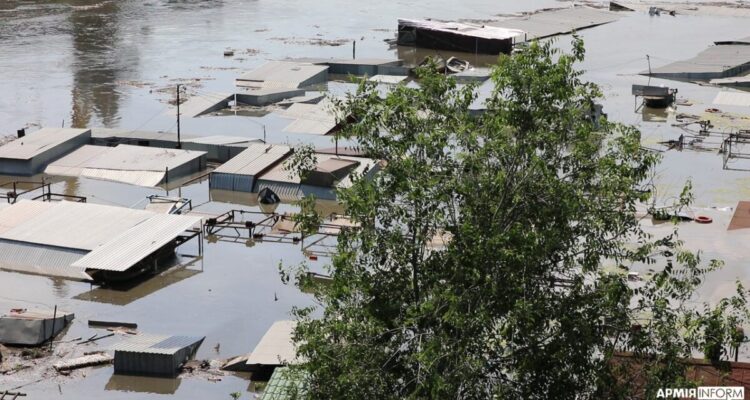In the early hours of Tuesday, June 6th a major dam on the Dnipro river in Russian occupied Ukraine suffered catastrophic damage. Floodwaters are now rushing downstream and sending tens of thousands of people fleeing, wreaking havoc across cities and farmlands, and disrupting drinking water supplies for hundreds of thousands of Ukrainians. Antonio Guterres called the dam’s destruction “a monumental humanitarian, economic and ecological catastrophe”
The Kakhovka dam was built over sixty years ago and forms a massive reservoir, roughly the size at the Great Salt Lake in Utah. Upstream, the dam provides water to prevent a meltdown at Europe’s largest Nuclear Power Plant. (The IAEA says there’s no immediate risk to the Zaporizhzhia Nuclear Power Plant — the cooling ponds are not rapidly depleting.)
Rather, it is downstream where this breach may have its most proximate impact on the trajectory of the conflict in Ukraine.
The path of these destructive floodwaters roughly follows the frontlines between Russian and Ukrainian forces in southern Ukraine — and the breach comes just as Ukraine’s much anticipated counteroffensive finally got underway.
This obviously raises the question: did Russia sabotage the Kakhovka dam to thwart a Ukrainian counteroffensive?
Probably, yes.
In an interview yesterday, the former US Ambassador to Ukraine John Herbst told me that all signs to point to Russian malfeasance. He explains that the now flooded battle lines along the Dnipro river were likely to be a key focus of a Ukrainian counteroffensive aimed at cutting off the “land bridge” between Russian-occupied Ukraine in the east and Russian-occupied Crimea in the south.
We spoke for an episode of the Global Dispatches podcast about the implications of this dam break in the context of Ukraine’s counteroffensive.
Go here to listen to the episode on your favorite podcast listening app
Here’s a partial transcript, edited for clarity Sign up for our free mailing list to get the full transcript.
Mark Leon Goldberg: So, we don’t have any definitive sense of how or why or who caused this damage at the dam. Do you have a sense though? What would you speculate happened?
John Herbst: Well, a cui bono analysis would point the finger at the Russians because this dam will seriously complicate Ukraine’s plans for a counter-offensive in the south. And we know the Russians have been extraordinarily nervous about this counter-offensive. So again, a cui bono analysis would point the finger at them. And what we know — what the international community knows — is that the Russians have mined that dam since last fall when they were worried about a possible Ukrainian offensive across the Dnipro river. And I’ve heard from non-official Ukrainian sources, but credible ones, that the explosion was from within. And that’s an area, of course, which the Russians control, as opposed to, being the result of Ukrainian artillery firing into the dam.
Mark Leon Goldberg: Yeah, I mean, it would seem that Occam’s Razor would suggest like the Russians did it.
John Herbst: Correct.
Mark Leon Goldberg: They have routinely targeted civilian infrastructure. It’s part of their whole war plan. They controlled the area. And the timing of this destruction also seems to coincide with the start of this much anticipated counter offensive.
Is there anything you could say about the timing of this counter offensive? Why are we seeing it finally get off the ground now after we’ve been sort of waiting for this to happen for for so long and anticipating it for so long?
John Herbst: Observers, including Russian observers, have thought this counter-offensive could have started early in the year when it was still winter. And we know the Russians have gotten increasingly nervous in regard to this offensive because Moscow’s own offensive dribbled out at Bahkmut. You know, they finally took that town, which Putin set as a deadline to be taken by the middle of December. But it’s cost them a minimum of 20,000 dead, according to the Wagner mercenary leader [Yevgeny] Prighozin’s own statements. U.S. and other Western intelligence agencies say the Russians have had 100,000 casualties, which is usually, three to four wounded to dead. So that’s a terrible, terrible cost for the Russians to take a town of no great strategic significance.
So they’ve been very, very defensive about that. They were defensive about the fact that you have this Russian opposition group that’s been creating some havoc in the Belgorod Oblast of Russia without any significant pushback by Russian forces. So it’s easy enough to imagine that spooked by the start of the Ukrainian counteroffensive, they decide now is the time to take out that damn.
Why the destruction of the Kakhovka Dam means we are entering a more perilous phase of the war in Ukraine.
If, indeed, Putin ordered the destruction of the dam on the very first day of a Ukrainian counter-offensive it would imply a willingness to sharply shift tactics beyond the routine attacks on civilian infrastructure we have seen thus far — the ruthless bombing of apartment buildings, schools and hospitals. Rather, blowing up a dam to forestall a Ukrainian advance suggests that Russia is willing to spark a major (and indiscriminate) ecological and humanitarian disaster if doing so is believed to provide some near term benefit to Moscow.
The dam destruction has battlefield implications. But it was also a signal, with the obvious implication that Putin’s next target could be upstream at the Zaporizhzhia Nuclear Power Plant, which Russia has occupied since March 2022. The area has been the scene of sporadic fighting, but in anticipation of a major Ukrainian offensive Russia recently ordered the evacuations of areas around the plant.
Putin probably ordered the destruction of the Kakhovka dam. But would he also instigate a major nuclear crisis, including the potential meltdown of Europe’s largest nuclear power plant?
That we do not know the answer to this question is what makes this moment so dangerous — for those in Ukraine and beyond.
